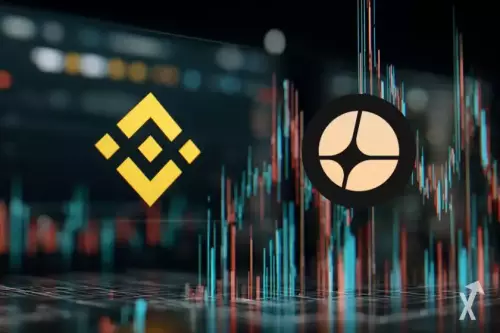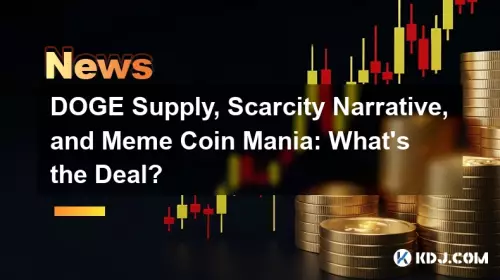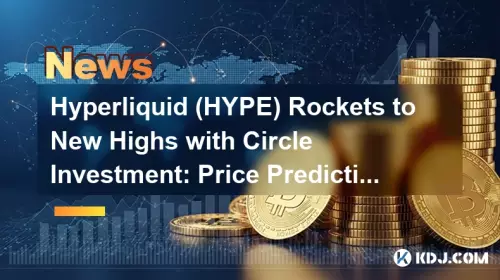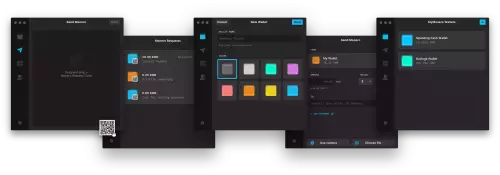 |
|
 |
|
 |
|
 |
|
 |
|
 |
|
 |
|
 |
|
 |
|
 |
|
 |
|
 |
|
 |
|
 |
|
 |
|
Articles d’actualité sur les crypto-monnaies
Dominic Williams : Réimaginer l'avenir de la blockchain et de l'IA avec le protocole informatique Internet
Jun 21, 2024 at 05:20 pm
Dans le paysage en évolution rapide de la technologie blockchain et de l’intelligence artificielle (IA), peu de visionnaires ont eu un impact aussi important que Dominic Williams.

Dominic Williams is the Founder and Chief Scientist of the DFINITY Foundation and the driving force behind the Internet Computer Protocol (ICP). In this exclusive interview, Williams shares his journey to founding DFINITY, the transformative potential of the Internet Computer Protocol, and the unique advantages of integrating AI with blockchain technology. He delves into the concept of Decentralized AI (dAI), its applications, and its crucial role in ensuring the integrity of AI training datasets. Williams also discusses the impact of AI smart contracts on Web3 and beyond, highlighting real-world examples and future opportunities for developers and researchers.
Dominic Williams est le fondateur et scientifique en chef de la Fondation DFINITY et la force motrice du protocole informatique Internet (ICP). Dans cette interview exclusive, Williams partage son parcours jusqu'à la création de DFINITY, le potentiel de transformation du protocole informatique Internet et les avantages uniques de l'intégration de l'IA à la technologie blockchain. Il approfondit le concept d'IA décentralisée (dAI), ses applications et son rôle crucial pour garantir l'intégrité des ensembles de données de formation en IA. Williams discute également de l'impact des contrats intelligents d'IA sur le Web3 et au-delà, en mettant en évidence des exemples concrets et des opportunités futures pour les développeurs et les chercheurs.
1. Could you start by sharing a bit about your journey and what led you to found the DFINITY Foundation and develop the Internet Computer Protocol (ICP)?
1. Pourriez-vous commencer par partager un peu votre parcours et ce qui vous a amené à fonder la Fondation DFINITY et à développer le protocole informatique Internet (ICP) ?
I’ve always been into computers, right from childhood. The interest peaked while pursuing my degree in Computer Science when I noticed the power of networked computers for the first time. One thing led to another and when I finally set out on my entrepreneurial journey in the mid-90s, I knew that I wanted to advance the area of distributed systems and the internet.
J'ai toujours été passionné d'informatique, depuis mon enfance. Cet intérêt a atteint son paroxysme pendant mes études en informatique lorsque j'ai remarqué pour la première fois la puissance des ordinateurs en réseau. Une chose en a entraîné une autre et lorsque je me suis finalement lancé dans mon parcours entrepreneurial au milieu des années 90, je savais que je voulais faire progresser le domaine des systèmes distribués et d'Internet.
After university, I was looking to build a “GameCoin” to support the creation of a pan-game virtual goods economy, and soon found that the technology necessary to create a GameCoin was missing, owing to the need for fast transaction times, low cost, and massive throughput. I spent most of my work thereafter repurposing classical distributed computing consensus techniques for the blockchain setting, and in 2014, published a paper describing the Pebble cryptocurrency. It was the first serious paper to propose architecture and mathematics designed to support an infinitely scalable cryptocurrency using classical distributed computing science.
Après l'université, je cherchais à construire un « GameCoin » pour soutenir la création d'une économie de biens virtuels pan-game, et j'ai vite découvert que la technologie nécessaire pour créer un GameCoin manquait, en raison de la nécessité de délais de transaction rapides et d'un faible coût. et un débit massif. J'ai ensuite consacré la majeure partie de mon travail à réutiliser les techniques classiques de consensus informatique distribué pour le contexte de la blockchain et, en 2014, j'ai publié un article décrivant la crypto-monnaie Pebble. Il s’agit du premier article sérieux proposant une architecture et des mathématiques conçues pour prendre en charge une crypto-monnaie infiniment évolutive utilisant l’informatique distribuée classique.
While working on Pebble, I proposed techniques to advance proof-of-work systems, and had become very involved with the early Ethereum community. Someone from that community came up with the term “World Computer.” My interpretation of that term was very different from the Ethereum community’s. I came to believe that a blockchain could extend the public internet with advanced “stateful serverless cloud” functionality. Consequently, my interests switched, my ambition grew, and I decided to pursue the creation of a World Computer.
Tout en travaillant sur Pebble, j'ai proposé des techniques pour faire progresser les systèmes de preuve de travail et je suis devenu très impliqué dans la première communauté Ethereum. Quelqu’un de cette communauté a inventé le terme « World Computer ». Mon interprétation de ce terme était très différente de celle de la communauté Ethereum. J’en suis venu à croire qu’une blockchain pourrait étendre l’Internet public avec une fonctionnalité avancée de « cloud sans serveur avec état ». Par conséquent, mes intérêts ont changé, mon ambition a grandi et j’ai décidé de poursuivre la création d’un ordinateur mondial.
I started using the term DFINITY for my work in 2015, which is short for “decentralized infinity.” My initial purpose was to support the creation of an Ethereum 2.0 or Ethereum 3.0. Eventually, though, the huge amount of research and engineering work involved in realizing the kind of World Computer I wanted to create, meant that it became its own project.
J'ai commencé à utiliser le terme DFINITY pour mon travail en 2015, qui est l'abréviation de « infini décentralisé ». Mon objectif initial était de soutenir la création d'un Ethereum 2.0 ou d'un Ethereum 3.0. Finalement, cependant, l’énorme quantité de travail de recherche et d’ingénierie impliquée dans la réalisation du type d’ordinateur mondial que je voulais créer a fait qu’il est devenu son propre projet.
The DFINITY Foundation was created in October 2016, and in 2018, the foundation raised investments from hedge funds and venture capital firms, including an early crypto investment from the renowned VC Andreessen Horowitz, before they began creating crypto-specific funds. There’s been no looking back since then.
La Fondation DFINITY a été créée en octobre 2016 et, en 2018, la fondation a levé des investissements auprès de fonds spéculatifs et de sociétés de capital-risque, y compris un premier investissement en cryptographie du célèbre VC Andreessen Horowitz, avant de commencer à créer des fonds spécifiques à la cryptographie. Depuis, il n’y a plus eu de retour en arrière.
2. What initially sparked your interest in blockchain technology and decentralized systems?
2. Qu'est-ce qui a initialement suscité votre intérêt pour la technologie blockchain et les systèmes décentralisés ?
My earliest connection to blockchain technology has to be from the late 90s when I was developing an online internet file storage system which relied on a cryptography library. This library had a link to a paper called b-money, which was an important antecedent to Bitcoin. I was intrigued by the concept, and it fostered my later strong engagement with blockchain tech. This preceded one of my earliest entrepreneurial exploits in building an MMO (massively multiplayer online) game for kids, which grew to 3 million users.
Ma première connexion à la technologie blockchain doit dater de la fin des années 90, lorsque je développais un système de stockage de fichiers Internet en ligne qui reposait sur une bibliothèque de cryptographie. Cette bibliothèque contenait un lien vers un article appelé b-money, qui était un antécédent important du Bitcoin. J'ai été intrigué par le concept et cela a favorisé mon engagement ultérieur dans la technologie blockchain. Cela a précédé l’un de mes premiers exploits entrepreneuriaux dans la création d’un jeu MMO (massivement multijoueur en ligne) pour enfants, qui a atteint 3 millions d’utilisateurs.
The service used a game server I created myself that could scale horizontally, just by adding new nodes, and was also the first major production system to use a now-famous database called Cassandra, which scaled similarly. This was a much needed learning curve as it allowed me to explore techniques related to scaling systems.
Le service utilisait un serveur de jeu que j'avais créé moi-même et qui pouvait évoluer horizontalement, simplement en ajoutant de nouveaux nœuds, et était également le premier système de production majeur à utiliser une base de données désormais célèbre appelée Cassandra, qui évoluait de la même manière. Il s’agissait d’une courbe d’apprentissage indispensable car elle m’a permis d’explorer les techniques liées aux systèmes de mise à l’échelle.
Over time, my natural inclination towards developing large computer systems gave me a high-level view of what kind of future platforms the world would need, and this became a driving factor in my founding DFINITY.
Au fil du temps, mon penchant naturel pour le développement de grands systèmes informatiques m'a donné une vision globale du type de plates-formes futures dont le monde aurait besoin, et cela est devenu un facteur déterminant dans ma création de DFINITY.
3. In what ways do you believe the Internet Computer Protocol will transform current Internet paradigms?
3. De quelle manière pensez-vous que le protocole informatique Internet transformera les paradigmes Internet actuels ?
The Internet Computer enables a new and much broader Web 3.0 paradigm, which involves full stack decentralization, in which blockchain replaces Legacy IT and Web 2.0
L'ordinateur Internet permet un nouveau paradigme Web 3.0 beaucoup plus large, qui implique une décentralisation complète, dans laquelle la blockchain remplace l'informatique héritée et le Web 2.0.
The Internet Computer is created by a decentralized network protocol called Internet Computer Protocol that is by far the most sophisticated ever devised. The protocol is the product of many world-famous cryptographers, computer science researchers and engineers working at DFINITY. It is extremely complex, and relies heavily on novel distributed computing math, cryptography, and other computer science.
L'ordinateur Internet est créé par un protocole réseau décentralisé appelé Internet Computer Protocol, qui est de loin le plus sophistiqué jamais conçu. Le protocole est le produit de nombreux cryptographes, chercheurs en informatique et ingénieurs de renommée mondiale travaillant chez DFINITY. Il est extrêmement complexe et s’appuie fortement sur de nouvelles mathématiques informatiques distribuées, sur la cryptographie et sur d’autres sciences informatiques.
We are the only blockchain network in the world that is capable of hosting social networks and enterprise systems. This ultimately means that ICP provides an alternative to the Legacy IT stack, which incorporates Web 2.0 infrastructures such as centralized cloud services run by Big Tech, which operate databases and web servers.
Nous sommes le seul réseau blockchain au monde capable d’héberger des réseaux sociaux et des systèmes d’entreprise. Cela signifie en fin de compte qu'ICP offre une alternative à la pile informatique héritée, qui intègre des infrastructures Web 2.0 telles que des services cloud centralisés gérés par Big Tech, qui exploitent des bases de données et des serveurs Web.
By allowing humanity’s systems and services to run entirely on a blockchain, we can
En permettant aux systèmes et services de l'humanité de fonctionner entièrement sur une blockchain, nous pouvons
Clause de non-responsabilité:info@kdj.com
Les informations fournies ne constituent pas des conseils commerciaux. kdj.com n’assume aucune responsabilité pour les investissements effectués sur la base des informations fournies dans cet article. Les crypto-monnaies sont très volatiles et il est fortement recommandé d’investir avec prudence après une recherche approfondie!
Si vous pensez que le contenu utilisé sur ce site Web porte atteinte à vos droits d’auteur, veuillez nous contacter immédiatement (info@kdj.com) et nous le supprimerons dans les plus brefs délais.
-

-

-

-

-

-

-

- Hyperliquide (Hype) Rockets à de nouveaux sommets avec Circle Investment: Prix Prediction Update
- Sep 18, 2025 at 05:59 pm
- L'hyperliquide (hype) défie les tendances du marché, en flèche de nouveaux sommets alimentés par l'investissement de Circle et la croissance des plates-formes. Est 100 $ en vue? Plongeons-nous dans l'analyse.
-

- Mymonero Wallet: une bouée de sauvetage de sécurité et de liberté financière
- Sep 18, 2025 at 05:56 pm
- Découvrez comment MyMonero Wallet a transcendé son rôle d'outil de cryptographie, devenant une bouée de sauvetage vitale pour la vie privée, la sécurité et l'indépendance financière dans des circonstances difficiles.
-

- Raila, Cryptocurrence et The Kenya Token: A New Dawn pour l'économie numérique du Kenya?
- Sep 18, 2025 at 05:55 pm
- L'ancien Premier ministre Raila Odinga dévoile le Kenya Token, une crypto-monnaie sur le point de révolutionner le système financier du Kenya et de positionner la nation en tant que leader de l'économie numérique en Afrique.





























































